![]() IDEAS
IDEAS
![]() Tweet
Tweet
 Vacation
Rentals
Vacation
Rentals
![]()
|
Made With |
|
|
|
|
Dr. Hoffer's Travel WebSite This site was last updated 05/18/13 |

Sunday August 22, 2010
Today is my oldest son Kevin's 38th birthday.
I woke at 1:45 AM and 7:00 and got up at 9:30. Being Sunday, I was on my way to Mass at the nearby church. On the way I took this shot to add to my collection of European city manhole covers. Some of them are interesting. See the little monk? It was a short walk. Below is a Bing map of the church.

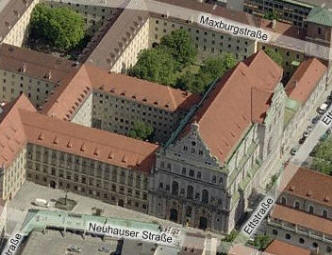
At 10:30 I attended Mass at Sankt Michael Kirche [6 Neuhauserstra�e.] This street is the extension of Kaufingerstra�e heading to Karlsplatz. It changes name near the church. This early baroque Jesuit church is the largest Renaissance church north of the Alps. Its style had an enormous influence on Southern German architecture. Remember, this was the church built by Wilhelm V from 1583-97. Having suffered severe damage during WWII, the church was restored from 1946-48.
The church crypt contains the tomb of Eug�ne de Beauharnais. A monument was erected by Bertel Thorwaldsen in 1830 in the church.
.jpg)
.jpg)
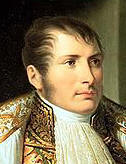 He was born in Paris and became the stepson and adopted child of Napoleon.
His natural father
Alexandre de
Beauharnais was executed during the revolutionary
Reign of Terror.
He married a daughter of King Maximilian I Joseph of Bavaria in 1806 and was
made Duke of
Leuchtenberg in 1817. Above his statue it says "Honor and Fidelity."
He was born in Paris and became the stepson and adopted child of Napoleon.
His natural father
Alexandre de
Beauharnais was executed during the revolutionary
Reign of Terror.
He married a daughter of King Maximilian I Joseph of Bavaria in 1806 and was
made Duke of
Leuchtenberg in 1817. Above his statue it says "Honor and Fidelity."
The ceiling is quite spectacular. Here is a shot I found of it. The main alter is below right.
.jpg)
Here is a painting of the church from 1723 (below left) and a photo of the front without the scaffolding covering it.
.jpg)
.jpg)
The pastor is Jesuit Fr. Theo Beirle (below left.) The Holy Water Basin is quite a work of art (below right.)
.jpg)
Here are some shots I made with PhotoStitch.
Here is the view looking toward the entrance (left) and a close-up of the organ (right.)
I love this dramatic shot of the sun streaming into the church.
Below left is a shot of the church after the WWII bombing.
.jpg)
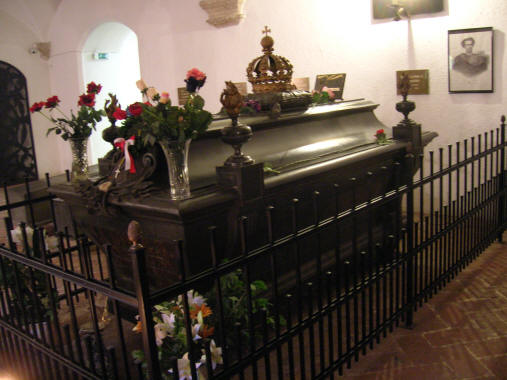
 Those buried here in the church are Wilhelm V, Maximilian Joseph, Ludwig II
(above right) and his brother Otto.
After I left, I needed a coffee and at 11:30 I headed for a cappuccino at
Rischart
nearby the church.
Those buried here in the church are Wilhelm V, Maximilian Joseph, Ludwig II
(above right) and his brother Otto.
After I left, I needed a coffee and at 11:30 I headed for a cappuccino at
Rischart
nearby the church.
And, of course, I forgot to tell them "No chocolate powder."
At 1:15 I went back to the room and took a shower. At 2:00, Marcia had lunch at the famous Augustiner Br�uhaus on Kaufingerstra�e. By 2:15 I was on my run, this time heading to the Deutches Museum Insel (island,) a place Dr. Neuhann told me I just had to see. I ran through the Viktualienmarkt, then down Blumenstra�e...

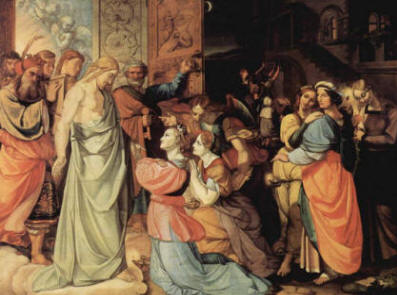
...and I f.jpg) inally
got onto a street
inally
got onto a street
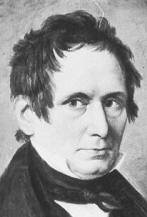 named
Corneliusstra�e. The name reminded me of the cataract pioneer, Cornelius
Binkhorst, but I found out later the street is named in honor of Peter von
Cornelius (1784�1867) (right) of D�sseldorf who was a famous German painter.
He
named
Corneliusstra�e. The name reminded me of the cataract pioneer, Cornelius
Binkhorst, but I found out later the street is named in honor of Peter von
Cornelius (1784�1867) (right) of D�sseldorf who was a famous German painter.
He
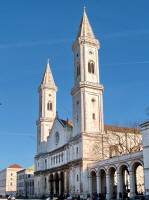 became
director of the
Munich Academy and did the fresco decorations of the
Ludwigskirche (left) which are thought by some to be the most important
mural works of modern times. The large fresco of the Last Judgment, over
the high altar in that church, measures 62 ft by 38 ft. His frescoes of
the "Creator," the "Nativity," and the "Crucifixion" in the same building are also
huge. Above right is an example of his work from 1813, "The Wise and
Foolish Virgins."
became
director of the
Munich Academy and did the fresco decorations of the
Ludwigskirche (left) which are thought by some to be the most important
mural works of modern times. The large fresco of the Last Judgment, over
the high altar in that church, measures 62 ft by 38 ft. His frescoes of
the "Creator," the "Nativity," and the "Crucifixion" in the same building are also
huge. Above right is an example of his work from 1813, "The Wise and
Foolish Virgins."
I kept going down that street until I reached and crossed the bridge over the Isar River but noted that there was no way to get to the museum from the other side of the bridge. Here are some shots I took of the river from the bridge.
There are these bastions on either side (above, below) where people are sitting out getting some sun and relaxing. Below right you can see the bridge I finally take.
I went back across the bridge and took Erhardstra�e and below are some of the architecture on this side of the river.
I reached the Boschbr�cke bridge (below right.) Before I crossed
I got this![]() shot of a large statue of Otto von Bismarck (1815-98) (below left)
holding a large sword. You can see the gate entry at the end of the
bridge.
shot of a large statue of Otto von Bismarck (1815-98) (below left)
holding a large sword. You can see the gate entry at the end of the
bridge.
.jpg)
.jpg)
I was now on Museuminsel (the "island in the river") and I kept
.jpg) running,
through the entry and the courtyard (below,) out the other entry and across the
Zenneckbr�cke bridge which crosses a silty branch of the Isar River. I
turned left and continued running down Zeppelinstra�e to Schmidstra�e among the
trees and along the river bank.
running,
through the entry and the courtyard (below,) out the other entry and across the
Zenneckbr�cke bridge which crosses a silty branch of the Isar River. I
turned left and continued running down Zeppelinstra�e to Schmidstra�e among the
trees and along the river bank.
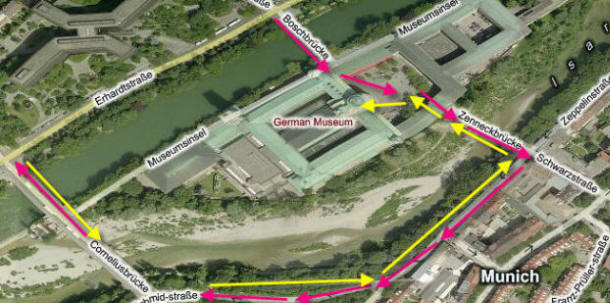
There are a lot of people enjoying the beaches formed by the river.
I made it back to the the museum (above) and the Zenneckbr�cke (below left) and finished my run back in the courtyard. When I went through the opening in the tower (below) I turned around and looked at the tower and noted their large 21 ft diameter astrological clock.
You can see the clock is indicating it is Sunday (bottom circle) and that it is now 2:37 PM. I better get moving; it closes at 5 PM.
.jpg)
.jpg)
They also had a Vertical Sundial which shows the true time based on the sun.
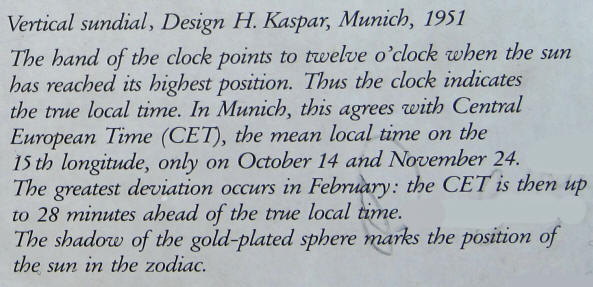
.jpg)
 Here is a Bing map overview of the whole
Deutches Museum [+49-892-1791.]
It is open every day from 9AM to 5PM. It is a very
large place that I'm told is impossible to see in one day but I'm going to try.
Here is a Bing map overview of the whole
Deutches Museum [+49-892-1791.]
It is open every day from 9AM to 5PM. It is a very
large place that I'm told is impossible to see in one day but I'm going to try.
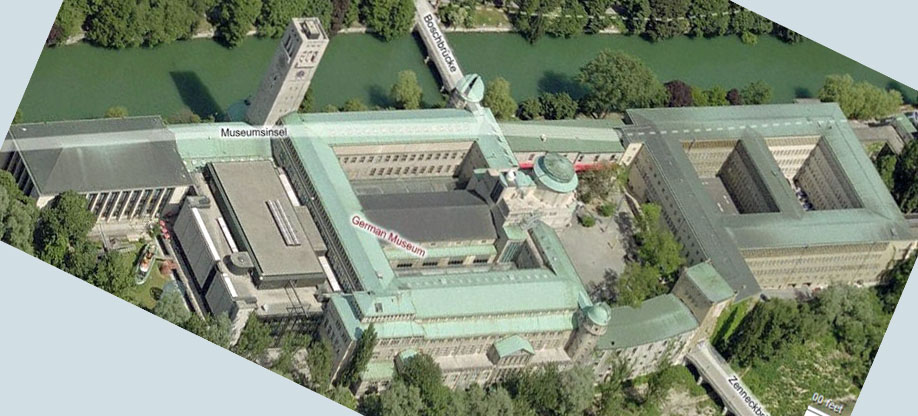

Here is a map of the many ways to get to it. For a floor plan map and index plan (below right) just right click Brochure and choose "Save Target As."
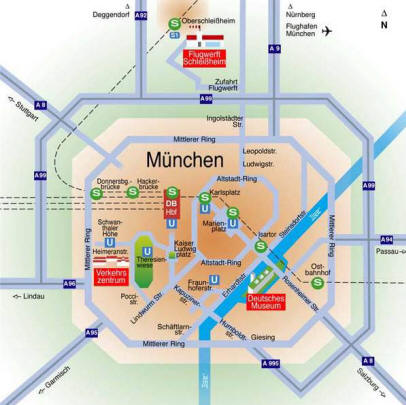
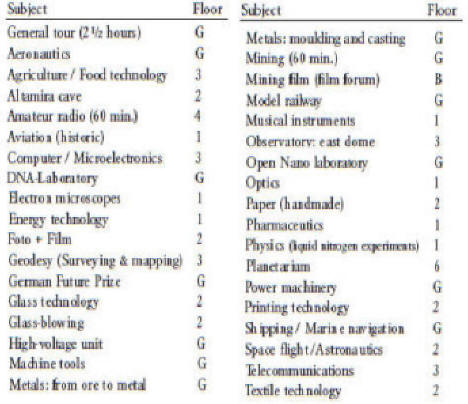
While still in the courtyard I looked at their display of turbines. This one is a 15-ton Pelton turbine from 1930.
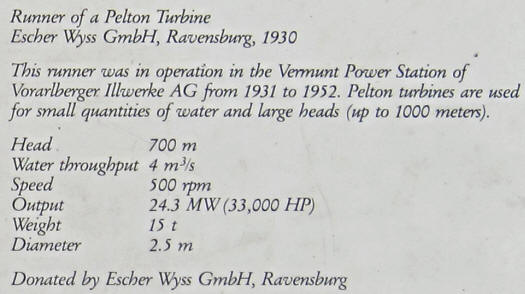
Below is a 1939 44-ton Francis turbine intended for delivery to Manchuria.
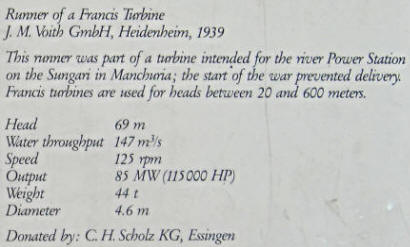
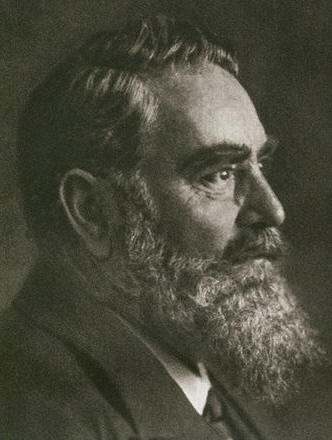 The Deutches Museum was founded in 1903 by
Oskar von Miller
(right) (Ring road named after him,) an engineer who made advances in electrical
current transport. He did this with the backing of Prince Regent
Luitpold and famous scientists and entrepreneurs such as
Max Planck,
Hugo Junkers,
Wilhelm Conrad Roentgen and
Emil Rathenau who
advised him on the structure of the departments. In 1906, Emperor Wilhelm
II laid the cornerstone of the museum complex in its current location on the
island. The architect was Gabriel von Seidle and until the grand opening,
which took place upon Miller's 70th birthday on May 7, 1925, smaller exhibits
were set up in provisional rooms. 80% of it was destroyed during WWII.
The Deutches Museum was founded in 1903 by
Oskar von Miller
(right) (Ring road named after him,) an engineer who made advances in electrical
current transport. He did this with the backing of Prince Regent
Luitpold and famous scientists and entrepreneurs such as
Max Planck,
Hugo Junkers,
Wilhelm Conrad Roentgen and
Emil Rathenau who
advised him on the structure of the departments. In 1906, Emperor Wilhelm
II laid the cornerstone of the museum complex in its current location on the
island. The architect was Gabriel von Seidle and until the grand opening,
which took place upon Miller's 70th birthday on May 7, 1925, smaller exhibits
were set up in provisional rooms. 80% of it was destroyed during WWII.
The front entrance to the museum is quite impressive.
All right, let's tackle this "largest museum in Germany." A full circuit of the entire museum is 10 miles (16 km;) it has 40 sections to explore. I entered the foyer and bought a ticket at 2:45 which cost �7 ($9.25.) It possesses 100,000 objects and 25,000 are on display.
.jpg)
First let's take a look at the overall outlook of this place. You can see all the physical sciences the museum covers. We'll see how many we can visit. Here is the Ground Floor.
.jpg)
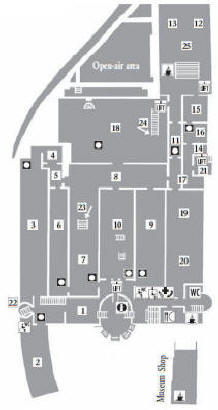
Here are the First and Second Floors.
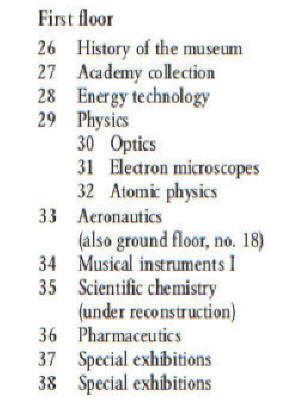
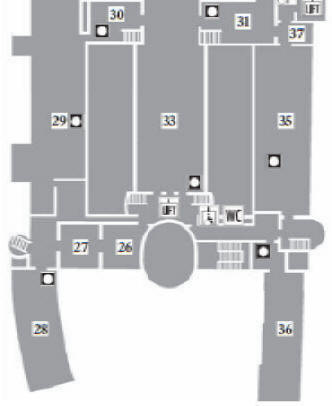
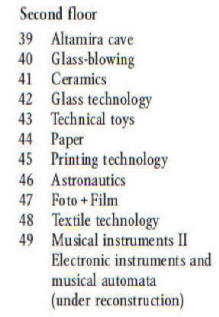
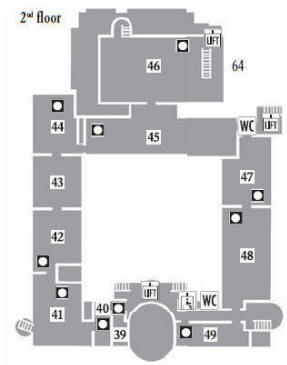
From the foyer, you first enter Room #10 which is Shipping and Marine Navigation.
The room is huge and several stories high allowing display of ships with tall masts. You can see that some of the Photostitching wasn't perfect (below right.)
Below is a section-cut model of a typical ferry liner (Silja.)
Here are the two sides of the Express liner Kaiser Wilhelm II.
.jpg)
Below is the Ewer Maria wooden fishing vessel.
.jpg)
Below left is the 1932 steam tugboat Renzo.
I left this area and walked through Room #8 which is labeled Machine Elements
which displayed various motors (above right.) Then I went into Room #18 which is Aeronautics.
They had this 1921 Grade auto here because Grade was an airplane builder.
.jpg)
There was a model of the Air France Concorde SST Marcia & I took in 1997.
.jpg)
In 1944, the company Mittelwerke (Nordhausen) built the very first large rocket in the world (below left) called the V-2 (Vergeltungswaffe-2.) Below right is the damage done by one of them on the city of Antwerp, Belgium on Nov 27, 1944.
.jpg)
They had this large display of a modern rocket I couldn't get all in one shot.
Just beyond Room #18, you exit outside to an Open Air section where they had a windmill, a boat and a communications dish.
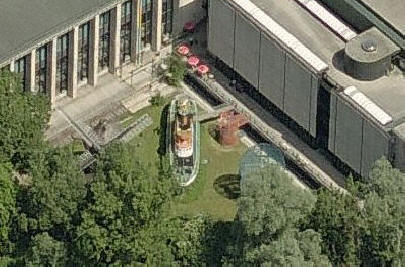
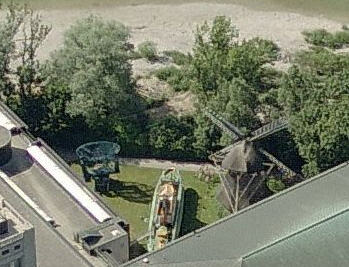
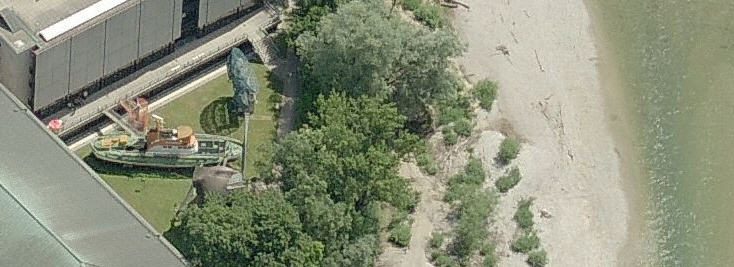
I went back inside to the airplane section.
They had a display showing the extent of the Munich Airport where we landed.
.jpg)
.jpg)
Then I worked my way back to the entrance and entered Room #9, Electric Power.
And then to Room #7, Power Machinery (below.)
They had this huge turbine hanging from the ceiling (below left.) Then I scooted by Room #17 (below right) which was Tunnel Construction.
Then I headed to the rear of the building again where there was a special area on the right for new technology which was down some stairs into the Basement.
After 45 minutes of running around, at 3:15 I found a place to rest for a minute and had a Cocalite.
After relooking at the map, at 3:40 I continued my visit. I headed back to the Basement area and went through Room #25, the Nano-Technology & Biology Area (above right & below.) They had touch screen exhibits but nothing was in English so I was at a loss.
Then into Rooms #12 & 13 for the DNA Laboratory.

The map above is to keep oriented. I now made my way into Room #15 Robotics. They showed this robotic cow-milking machine (below.)
.jpg)
Then into Room #16 Model Railways.
.jpg)
.jpg)
Above is a map layout of the laid-out model railway shown below.
I came out of that room and looked over the edge to the floor below (left) and watched the Foucault's Pendulum swinging back and forth. Later I went down and got a closer shot of it (below right.)
For those not familiar with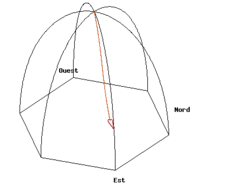 it, it is a tall pendulum free to
it, it is a tall pendulum free to oscillate in any vertical plane. The direction along which the pendulum swings
appears to rotate with time because of the Earth's daily rotation. This is
because the plane of the pendulum's swings, like a
gyroscope, tends to keep a
fixed direction in space, while the Earth rotates "under it." It was first
demonstrated by French physicist
L�on Foucault (1819�68)
(above) in 1851 which was the first real proof that the earth rotated. On the
right above is an animation with the Earth's rotation rate greatly exaggerated.
oscillate in any vertical plane. The direction along which the pendulum swings
appears to rotate with time because of the Earth's daily rotation. This is
because the plane of the pendulum's swings, like a
gyroscope, tends to keep a
fixed direction in space, while the Earth rotates "under it." It was first
demonstrated by French physicist
L�on Foucault (1819�68)
(above) in 1851 which was the first real proof that the earth rotated. On the
right above is an animation with the Earth's rotation rate greatly exaggerated.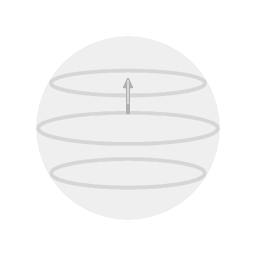 The green trace shows the path of the pendulum bob over the ground (a rotating
reference frame,) while the blue
The green trace shows the path of the pendulum bob over the ground (a rotating
reference frame,) while the blue
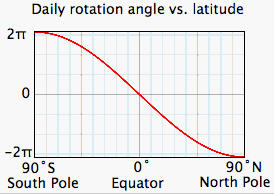 trace
shows the path in a frame of reference rotating with the plane of the pendulum.
The animation (left) shows the motion of a Foucault Pendulum at a latitude of
30� north. The plane of oscillation rotates by an angle of 180� during one
day, so after 2 days the plane returns to its original orientation. It
rotates the most at the poles and not at all at the equator (graph above right.)
Below is the first and largest one built by him in the Pantheon in Paris.
We will see it in a couple of weeks.
trace
shows the path in a frame of reference rotating with the plane of the pendulum.
The animation (left) shows the motion of a Foucault Pendulum at a latitude of
30� north. The plane of oscillation rotates by an angle of 180� during one
day, so after 2 days the plane returns to its original orientation. It
rotates the most at the poles and not at all at the equator (graph above right.)
Below is the first and largest one built by him in the Pantheon in Paris.
We will see it in a couple of weeks.
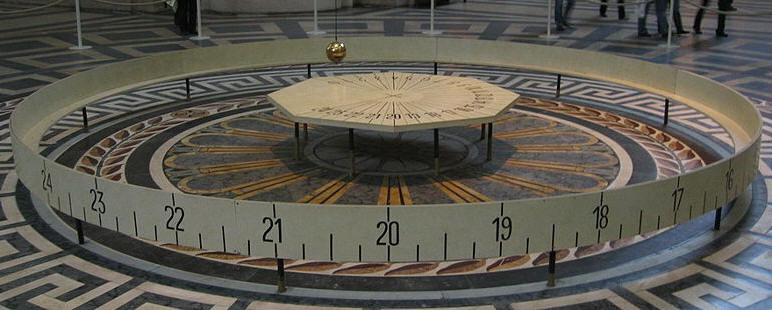
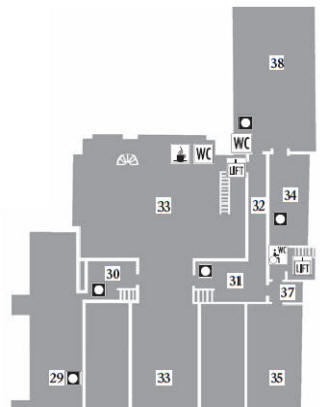

Then I went up to the 1st Floor and found Room #34 with the display of Musical Instruments from ancient to modern.
They have a harpsicord dating from 1561.
As can be seen they had rooms and rooms of them.


I then entered Room #29, the area labeled Physics. I missed Room #36 Pharmaceuticals or it was closed.
.jpg)
They had a display on X-rays and some early equipment used to generate them.
.jpg)
Then into Room #31, an area called Atomic Physics displaying microscopes and telescopes.
.jpg)
Here (below left) in Room # 31 they have an old electron microscope. They had a laser image demo I thought I could get shots showing it changing but I was unsuccessful.
Then in Room #30 Optics, they had this display showing the light going through the various optical elements and I took a shot of it without the flash to show the lights and one with a flash that shows the elements without the light.
I then found myself back in the upper level of the Aeronautics Room which here is Room #33 and here they looked at the history of flight. There were the earliest successful attempts using hot air balloons such as the very first one by Fr. Bartolomeu de Gusm�o and the later successful free attempts by the Montgolfier brothers in Annonay, France in 1783. I discussed a lot on this in the France Diarios.
.jpg)
Here is a blow-up of the painting of Fr. de Gusm�o demonstrating his hot air balloon to King John V in Lisbon in 1709 (below left.) Below right are other balloons built by the Roberts brothers in Paris who made the first one using steam.
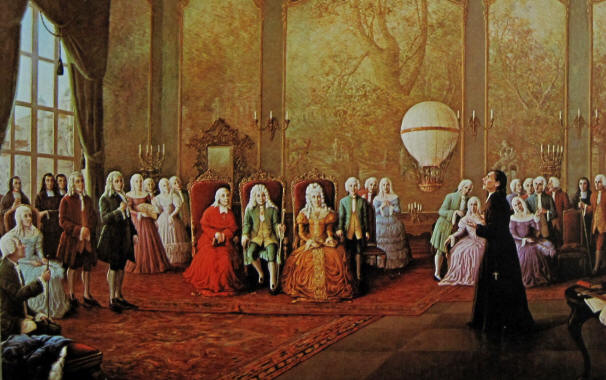
From there we go to dirigibles (below left) and then man-flight contraptions (right.)
And finally a real actual Wright brother's motorized airplane.
Being on the upper floor, I can now see the entire size of that sailing ship I saw when I first entered the museum on the Ground Floor.
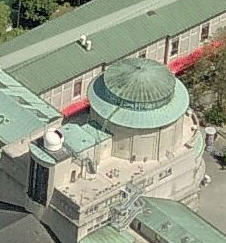
I then climbed up the spiral stairs (below right) all the way to the 6th floor in the observatory tower (above right, below left) but everything seemed closed. I couldn't get into the Zeiss Planetarium (Room #63) because it closes earlier.
From here I could see out as far as the Frauenkirche church towers (below left.) You can see the Zeiss Planetarium in the foreground which is 49 ft (15m) across.
Here are views to the east and the west. Above right is a zoom-in on the church you can see below left.
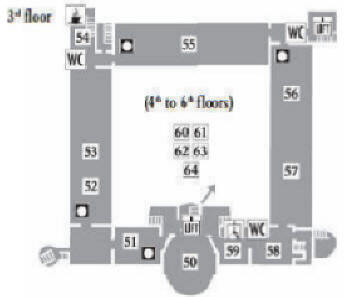
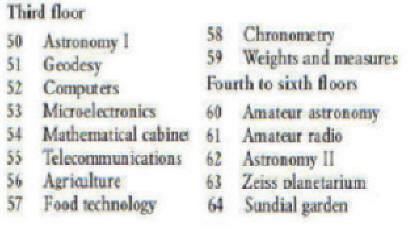
I went back inside and this lead me to Room #62 on Astronomy II.
.jpg)
This area has 180 exhibits and there were displays of various observatories with telescopes.
Then into Room #60 Amateur Astronomy and there was an interesting model of Stonehenge in England demonstrating how the stones lined up with the sun. Left is a shot with the flash and on the right without.
Then there was Room #60 for Amateur Radio with a large map showing the ham radio spots on the world.
.jpg)
Then I was back into the Astronomy Room.


I had climbed from the 6th to the 3rd Floor in the process and now entered Room #50 Astronomy I.
.jpg)


Then I went into Room #59 to the right on Weights and Measures (Ma� und Gewicht.)
.jpg)
This display (below) was of a 1769 Italian weighing device by Francisci and Theresle.
.jpg)
Then to Room #58 on Timekeeping (Zeitmessung.)
.jpg)
Then a large area including Room #57 on Food Technology starting off with grinding mills.
.jpg)
They had huge scale models of food processing plants. Below is just one.
They had a series of more modern grinding mills. As you can see, some of the exhibits, but not many, had descriptions in English.
.jpg)
There are exhibits of distillers.
.jpg)
This large room also held Room #56 Agriculture.
.jpg)

.jpg)
Then I went into Room #55 Telecommunications and Broadcasting of sound and pictures. They went from modern (below right) to ancient.
.jpg)
.jpg)
Here was the exhibit of Gauss and Weber's attempts at the 1st telegraph.
.jpg)
Then I entered a small area (Room #54) in the corner titled Mathematical Cabinet with this large tiling pattern called Penrose Tiling which I have never heard of.
.jpg)
You can read about Penrose (below left) and his instructions on laying the pattern (below right.)
.jpg)
.jpg)
There were several young people there working on something.


From there I entered Room #52 Computer Science with a display of the very first computers.
%20(2).jpg)
All this probably fits in an iPad or smartphone today.
Then there was an area displaying early "calculators" and Cryptology Devices.
.jpg)
Then specialized slide rules.
.jpg)
.jpg)
.jpg)


Then I turned the corner and entered Room #51 on Geod�sie (Surveying and Mapping.)
.jpg)
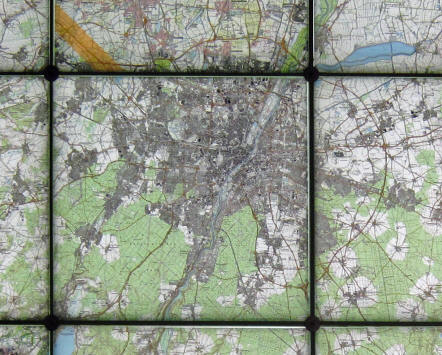
.jpg)


I think its getting close to closing time and I am pretty exhausted so I have to move fast. I was on the First Floor (above) and came across Room #28 Energy Technology. Here they had a room replicating older tools such as winches and pulleys.
They had displays on Nuclear and Solar energy.
.jpg)
.jpg)
.jpg)
The display below is explained in German (above right.) The wire was oscillating at such a speed that without the flash (left) the eye's view looked like there was two of them, but with a flash (right) it is just one.
As I was trying to find my way out, I came across displays of oil drilling. The diagrams below are of the drilling mechanisms of Kind-Chaudron (left) and Fritz Honigmann (right.)
.jpg)
I then had to go through Room #27, the Academy Collection with more telescopes. Below center is a 1760 Quadrant made by G. F. Brander.
Then to Room #26 showing the History of the Museum.
.jpg)
The Museum really has four parts. They have scale models of them. The 1st is the museum I am in now (below.)
.jpg)
The 2nd is the Schliessheim Airfield (below) here in Munich which holds many more airplanes.
.jpg)
The 3rd is the DM Verkehrszentrum (below,) also here in Munich. The 4th is a branch of the DM in the capitol, Berlin.
.jpg)
Finally to the last room displaying Mineral Oil and Natural Gas (below left) and finally the statue above the exit door (below right.) I'm done!
At 5:00 I was finally out (at closing time) having spent almost 3 hours going through it. I missed a few things [Paper & Printing, Pharmaceuticals (with model of human cell,) Glass Technology, Photography & Film and Textiles] but not too much. I didn't see the 1st car made by Carl Benz, the 1st Diesel engine and worst of all the recreation of Spain's Altamira Cave which has the Stone Age pictures and (now closed to the public.) I guess I'll have to come back someday.
I then went into their huge Museum Shop (below) packed with people.
They had a lot of interesting things you could buy like these distillery units (below left,) kits and robots. Not interested in lugging anything back to the USA, at 5:15 I started my walk back to the hotel (below right.)
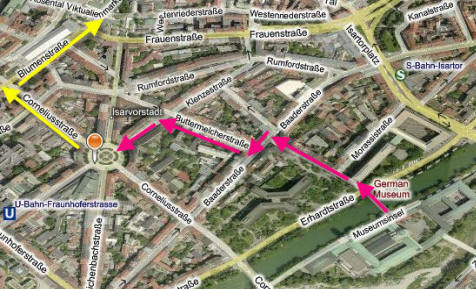
I crossed the bridge and headed down Kohlstra�e on my way to Baaderstra�e and on the left...

...I saw a large art display at the corner of this building (below left) and on the right a sign for the German Patent office.
.jpg)
.jpg)
Then I went by the Hotel Admiral (below left) and a cute little shoe shop (below right.)
I turned left and came across the K�nigs Quelle restaurant [2 Baaderplatz, +49-8-922-0071] with outdoor seating.
Then I made a quick right onto Buttermelcherstra�e
![]() and
headed past all the stately buildings. I believe that means buttermilk.
and
headed past all the stately buildings. I believe that means buttermilk.
Several garage door had this sign (below left) and I think "abgeschleppt" means your going to get towed. At the end of the street I turned left onto Klenzestra�e...
.jpg)
.jpg)
...and at the end there seemed to be something interesting. I got there and discovered I was in G�rtnerplatz (Bing map below.)

It sure was a beautiful and peaceful little spot. Below is the view as I entered.
.jpg)
At 5:30,
I went half way around the circle to see this impressive building I
discovered is the Staatstheater (State Theatre)
which is an
opera house and
opera company. It was designed by the architect
Michael Reiffenstuel and opened in November 1865 as the city's second
opera house after the
National Theatre. The latter is the large one near the Residenz and
across from the Spatenhaus where we ate. That one is officially the National Theatre Munich
and the home of
the Bavarian State
Opera and the Bavarian State Ballet (Bayerisches
Staatsballett.)
.jpg)
In the little park in the middle of the circle (above) I came across this statue.
.jpg)
It leads to another interesting diversion. It was a memorial to Leo von
Klenze (1784-1864) who had been
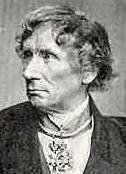 a
court architect (Baumeister) of
J�r�me Bonaparte (King of
Westphalia) from 1808-13 and then moved to
Munich and did the same for King Ludwig I in 1816. He designed much of
what you see in Munich today. He did the Glyptothek (1816�1830,) the
Propyl�en Gate (1846�1862,) the Alte Pinakothek (1826�1836,) and in the
Residenz; the K�nigsbau, the Festsaalbau and the
Allerheiligen-Hofkirche (1826�1842.)
a
court architect (Baumeister) of
J�r�me Bonaparte (King of
Westphalia) from 1808-13 and then moved to
Munich and did the same for King Ludwig I in 1816. He designed much of
what you see in Munich today. He did the Glyptothek (1816�1830,) the
Propyl�en Gate (1846�1862,) the Alte Pinakothek (1826�1836,) and in the
Residenz; the K�nigsbau, the Festsaalbau and the
Allerheiligen-Hofkirche (1826�1842.)
He was responsible for the Monopteros temple (1836) (below left) (and another at Nyphenberg Schloss) as well the Steinerne Bank (Stone Bench) (below right) both in the Englischer Garten.

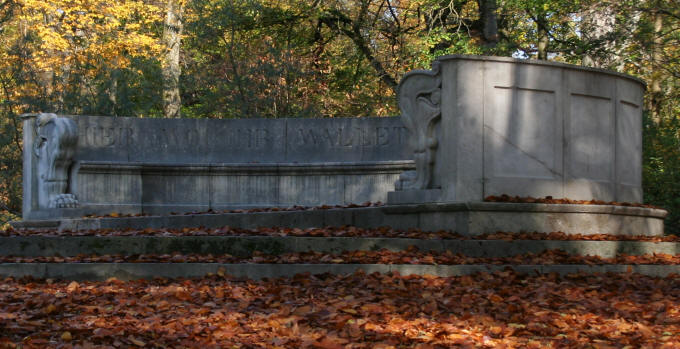
He also did many things outside of Munich including the Walhalla temple (below) near Regensburg (1816�1842) which honors famous Bavarians. He did the Catholic church of St. Dionysios the Areopagite in Athens, Greece (1853�1865)
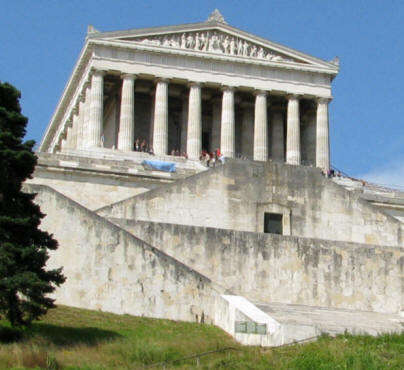
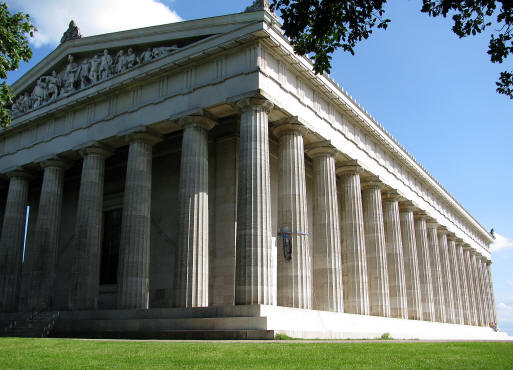
You can see he liked ancient Greek architecture. But most grandiose and amazing of his many works is the New Hermitage (Winter Palace) in St. Petersburg, Russia (1839�1852.) Below are two shots of it. We saw it in 2003.


Getting back to Munich, he designed Ludwigskirche (below) next to the Ludwig Maximilian University on Ludwigstra�e
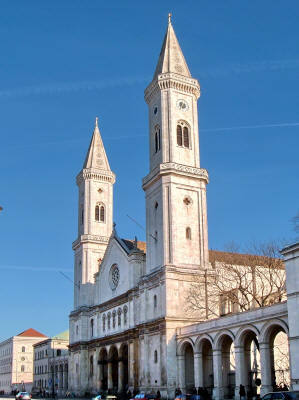
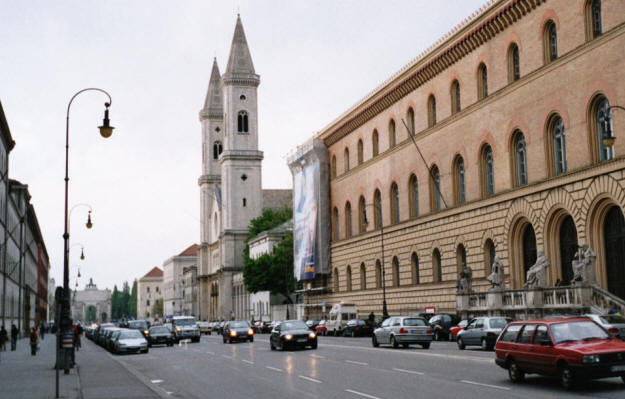
And he also did the
Ruhmeshalle (1850) [16 Theresienh�he,
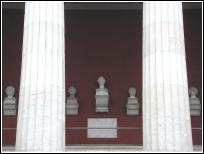 +49-8-929-0671]
which consists of a U-shaped building with 48 Doric marble columns located in
the area where they hold the Oktoberfest. The building has allegories to
the four Bavarian provinces (Bavaria, the Palatinate, Swabia and Franconia) in
the tympana of both side wings. In the hall itself there are 108 busts of
prominent Bavarian personalities. Many of them were destroyed in WWII but
they have been working on replacing them since 1969. In 2000 the first
female busts were added. Below is a shot I found of Ruhmeshalle.
+49-8-929-0671]
which consists of a U-shaped building with 48 Doric marble columns located in
the area where they hold the Oktoberfest. The building has allegories to
the four Bavarian provinces (Bavaria, the Palatinate, Swabia and Franconia) in
the tympana of both side wings. In the hall itself there are 108 busts of
prominent Bavarian personalities. Many of them were destroyed in WWII but
they have been working on replacing them since 1969. In 2000 the first
female busts were added. Below is a shot I found of Ruhmeshalle.
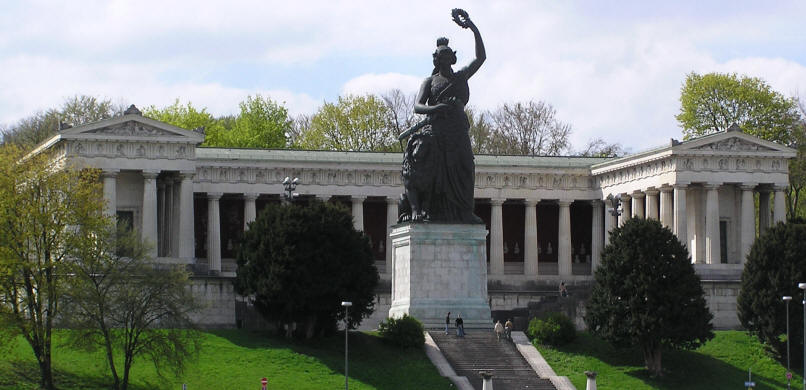
Of course, there is a bust of Ludwig I himself. In the center their is a marble plaque listing the names of those busts that were destroyed by the WWII bombing.
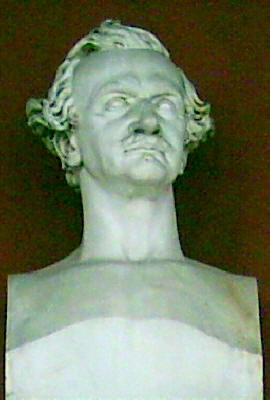

There is one of George Ohm (below left) who defined electrical resistance and the units are now named ohms. Below right is one of the first female busts; of actress Clara Ziegler.
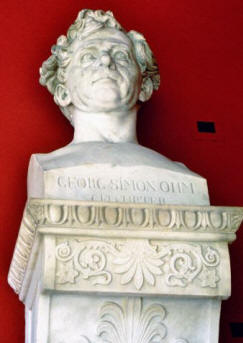
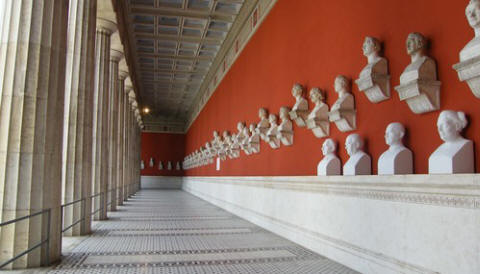
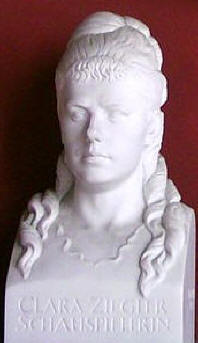
The only bust (below left) I
 found
of relevance to me was
Joseph von
Fraunhofer (1787-1826) who was a German optician and physicist who invented
the spectroscope (below
right.) He discovered the dark absorption lines in the sun's spectrum now
known as Fraunhofer
lines (above)and he was known for making excellent optical glass and
achromatic telescope objectives.
found
of relevance to me was
Joseph von
Fraunhofer (1787-1826) who was a German optician and physicist who invented
the spectroscope (below
right.) He discovered the dark absorption lines in the sun's spectrum now
known as Fraunhofer
lines (above)and he was known for making excellent optical glass and
achromatic telescope objectives.
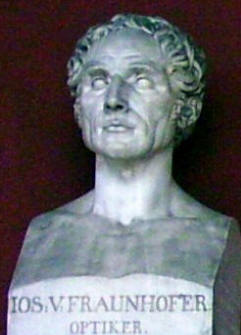
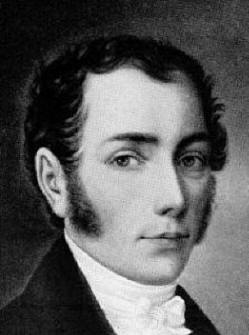
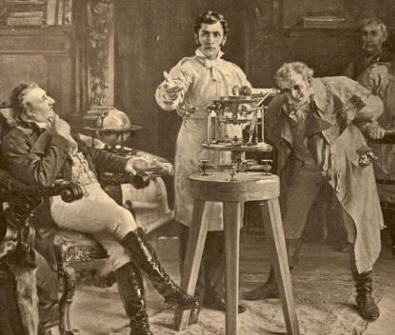
Below are more photos of the statues. The largest below left is of Sebastian Kneipp (Pfarrer=Pastor.) To see a complete list of all the Names, click it.
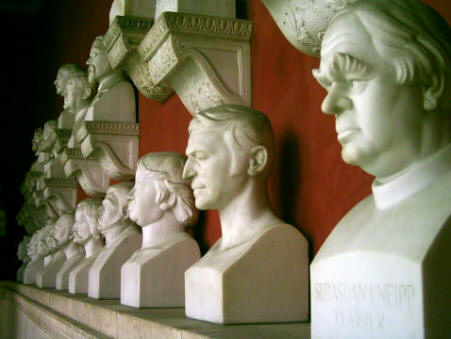
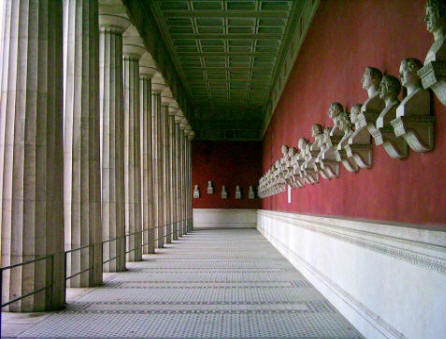

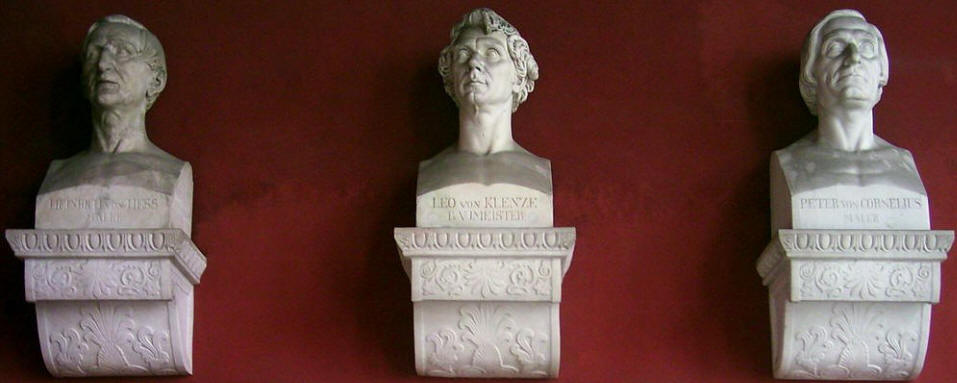
The last three busts are of Heinrich von Hess, Leo von Klenze and Peter von Cornelius.
In front of the Ruhmeshalle building is "Bavaria," (below left) the name given to a monumental, bronze sand-cast 19th Century female personification of the Bavarian homeland, and by extension its strength and glory. It was designed by sculptor Ludwig Schwanthaler. In 2001 it was closed to visitors for long-needed refurbishment. Inside the statue is a spiral staircase (below right) which you can climb to the head.

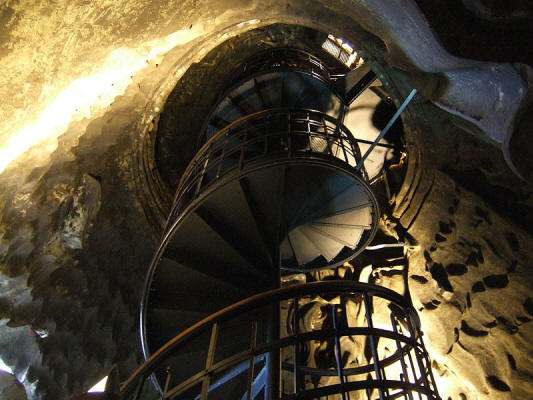
A closer look at her face is quite intriguing (below left.) Inside her head there are two bronze sofas (below right) for what reason I have no idea.
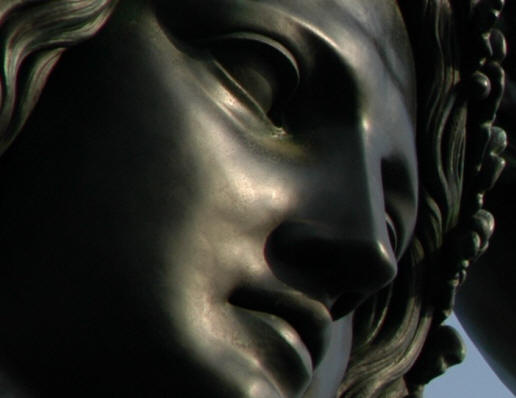
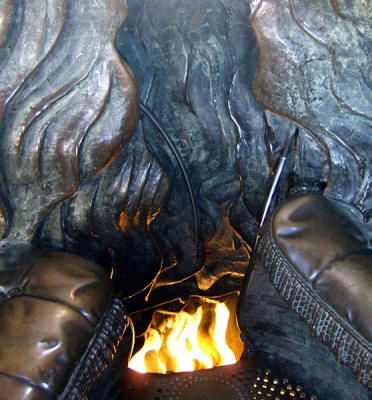
.jpg) Getting back to G�rtnerplatz, I discovered
there was a second statue on the other side. Someone decided to leave a
note on his forehead. On the back side of the monument there was this
inscription (right) that says "These busts were part of monuments in this platz and were melted in WWII (1939-45.)"
Getting back to G�rtnerplatz, I discovered
there was a second statue on the other side. Someone decided to leave a
note on his forehead. On the back side of the monument there was this
inscription (right) that says "These busts were part of monuments in this platz and were melted in WWII (1939-45.)"
.jpg)
This one was of
Friedrich von G�rtner of
Koblenz (1792-1847.) G�rtner and
Leo
 von
Klenze are the most well known architects (Baummeisters) of Bavaria during
the reign of Ludwig I. These two were really incredible. G�rtner is
responsible for the
Feldherrenhalle, the
Siegestor, the Ludwig
Maximilian
University building, and the
Bayerische Staatsbibliothek (Bavarian State Library.) Outside of
Munich he built the
Befreiungshalle in Kelheim
and the Royal palace in Athens, which is now used as the
Hellenic Parliament.
von
Klenze are the most well known architects (Baummeisters) of Bavaria during
the reign of Ludwig I. These two were really incredible. G�rtner is
responsible for the
Feldherrenhalle, the
Siegestor, the Ludwig
Maximilian
University building, and the
Bayerische Staatsbibliothek (Bavarian State Library.) Outside of
Munich he built the
Befreiungshalle in Kelheim
and the Royal palace in Athens, which is now used as the
Hellenic Parliament.
Here is some of his impressive work. Below is the Ludwig Maximilian University building (left) and its interior main hall (right.) This is where the White Rose movement passed out there leaflets.
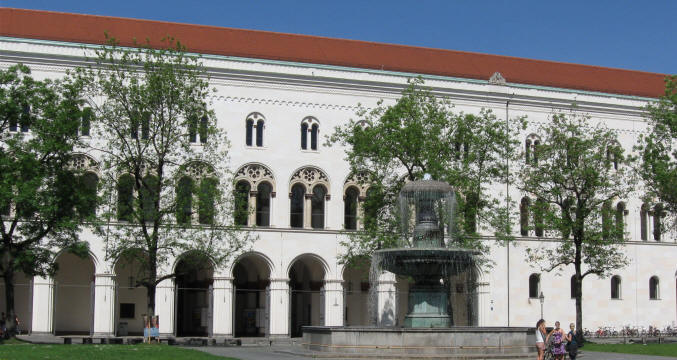
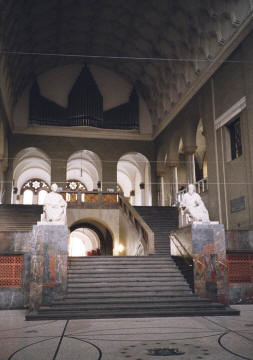
Below is the Befreiungshalle in Kelheim (left) and the Hellenic Parliament in Athens (right.)
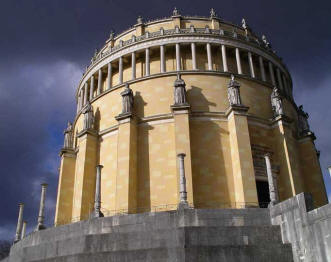
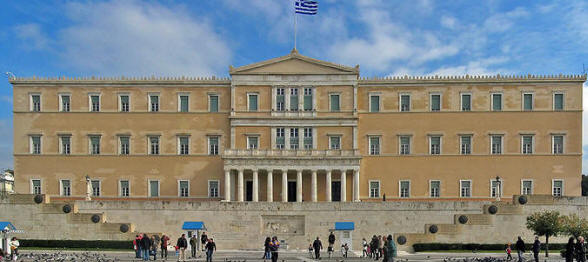
Below is the Bavarian State Library exterior (left) and its impressive main hallway (right.)
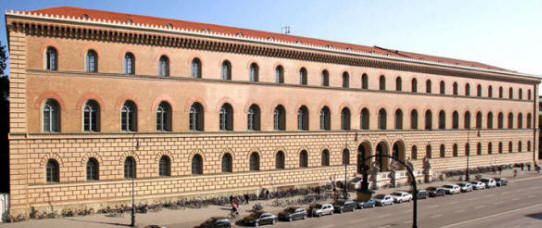
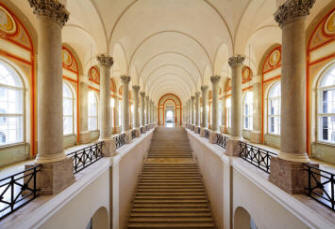
 At 5:35 I was feeling I needed another cappuccino and was not in the mood for a
beer. I decided to stop in this cute little place right on the square
called Le Pain Quotidien [6
G�rtnerplatz,
+49-89-24-207-8610.] Below are views left and right.
At 5:35 I was feeling I needed another cappuccino and was not in the mood for a
beer. I decided to stop in this cute little place right on the square
called Le Pain Quotidien [6
G�rtnerplatz,
+49-89-24-207-8610.] Below are views left and right.
This is basically a bakery (below left) that sells salads, etc. I maneuvered a table out on the patio and ordered this cappuccino (below right.) It came in this huge soup bowl with no handles on it making it quite difficult to drink.
.jpg) At 6:35 I paid up and started my walk back to the hotel. I wended my way
back
to Blumenstra�e and got a shot of this interesting building (below left.)
I finally got a good shot of a Munich police car.
At 6:35 I paid up and started my walk back to the hotel. I wended my way
back
to Blumenstra�e and got a shot of this interesting building (below left.)
I finally got a good shot of a Munich police car.
.jpg)
As I got closer to familiar territory I came across
.jpg) the
Bauhaus M�nchen building (a real estate
developer) on Sendlinger Stra�e. Across
the street was one of those circular posts you see often in Paris. It was
advertising a movie called "Das Leben ist zu Lang" ("Life is too Long".)
the
Bauhaus M�nchen building (a real estate
developer) on Sendlinger Stra�e. Across
the street was one of those circular posts you see often in Paris. It was
advertising a movie called "Das Leben ist zu Lang" ("Life is too Long".)
.jpg)
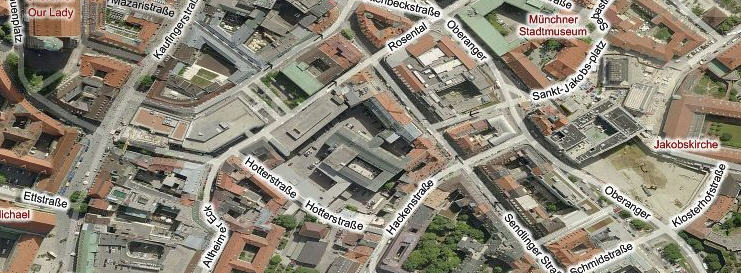
.jpg)
I made it back to St. Jakobs Platz and was able
.jpg) to
get a side shot (above right) and this beautiful late afternoon shot of the Jewish Synagogue. Now with
its tall thin doors closed, I was able to take a photo of the finely inscribed
doors. My friend, Dr. Arnie Seid told me the inscription is the first 10
letters of the Hebrew alphabet. When I was here last time, they were open and there were some
serious guards standing at them and I was a little paranoid going up and
photographing them.
to
get a side shot (above right) and this beautiful late afternoon shot of the Jewish Synagogue. Now with
its tall thin doors closed, I was able to take a photo of the finely inscribed
doors. My friend, Dr. Arnie Seid told me the inscription is the first 10
letters of the Hebrew alphabet. When I was here last time, they were open and there were some
serious guards standing at them and I was a little paranoid going up and
photographing them.
.jpg)
Below left is the sign for the Kosher eatery they have here. On the right is the only sign I saw celebrating the German victory in the 2010 soccer World Cup. It was in one of the bus waiting stands. "Echte Liebe" means "True Love."
.jpg)
Here is a good shot of the Jewish Museum that I discussed yesterday.
.jpg)
.jpg) As I kept going on Oberanger, here is the other side of the M�nchener
Stadtsmuseum (below left) which shows a more modern wing at the corner of
Rosental and Oberanger.
As I kept going on Oberanger, here is the other side of the M�nchener
Stadtsmuseum (below left) which shows a more modern wing at the corner of
Rosental and Oberanger.
Above right is the approach to Pettenbeckstra�e (map below.)
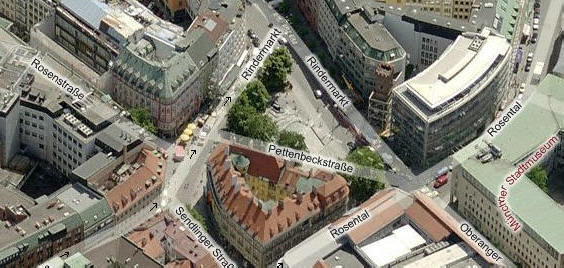
As I walked up Pettenbeckstra�e (above right,) I then arrived at the little
triangular park on Rindermarkt with the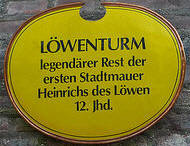 cattle fountain (Rinderbrunnen) (below left) built in 1964 as a reminder that
this was the city cattle market. The nearby water tower called L�wenturm
(below right) dates to Medieval times and looks it. The name comes from
Henry the Lion (L�wen) who had it built in the 12th Century as part of the first
city walls. It took 3 photos to get this shot.
cattle fountain (Rinderbrunnen) (below left) built in 1964 as a reminder that
this was the city cattle market. The nearby water tower called L�wenturm
(below right) dates to Medieval times and looks it. The name comes from
Henry the Lion (L�wen) who had it built in the 12th Century as part of the first
city walls. It took 3 photos to get this shot.
From the Bing map below on the left you can see the location of the park (arrow) and on the right the position of the tower (arrow.) The beautiful Rosen Apotheke building is prominent in the left map.


Here is a shot of it I found showing it stuck in between these two modern buildings. It seems there's always a vehicle parked in front of it.
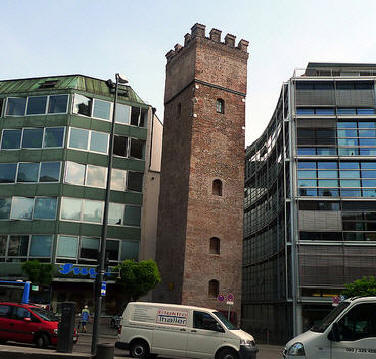
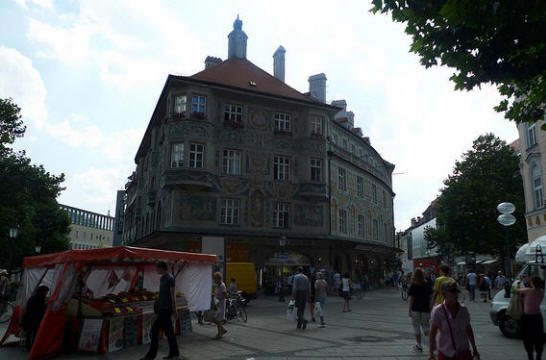
The walk from here back to the hotel goes
.jpg) from
Rindermarkt to Rosenstra�e at Rosen Apotheke (below left.) Here (above
right) is the view from the Apotheke. I go down the street on the right
called F�rstenfelder Stra�e (below right) past the new offices of S�ddeutsche
Zeitung (the major local newspaper) and then ...
from
Rindermarkt to Rosenstra�e at Rosen Apotheke (below left.) Here (above
right) is the view from the Apotheke. I go down the street on the right
called F�rstenfelder Stra�e (below right) past the new offices of S�ddeutsche
Zeitung (the major local newspaper) and then ...
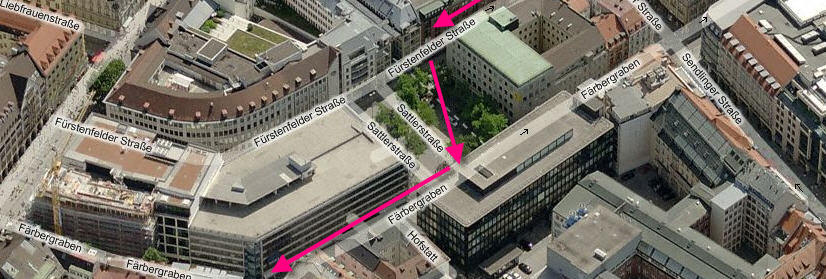
... take a short cut (arrows) through the BundesPost parking lot (below left) on Sattlerstra�e (above) around the big parking building and then down F�rbergraben to our hotel at the end on the left (below right) at Hotterstra�e. If you turn right at the hotel, F�rbergraben continues as a short pedestrian street to Kaufingerstra�e.
As I turn that corner, I keep taking shots of the redevelopment of the S�ddeutsche Zeitung newspaper's old building as it progresses over the years. Right now it detracts from our hotel a little but will be finished some day.
I got back to the the room at 7:00 and changed and
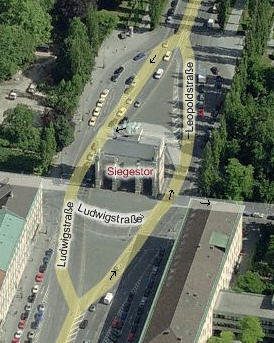 then
Marcia and I walked back to Odeonsplatz hoping we could walk the rest of the way
but at 8:00 we caught a cab to Schwabing where all the restaurants are located
then
Marcia and I walked back to Odeonsplatz hoping we could walk the rest of the way
but at 8:00 we caught a cab to Schwabing where all the restaurants are located
 because
Marcia didn't feel she could walk any further (cost �8.) As we go from
Ludwigstra�e to Leopoldstra�e we pass the large Siegestor (left & lower right
corner in map below) the triumphal arch erected by King Ludwig I in 1843-50 in
honor of the Bavarian Army's part in the victory over Napoleon. The
architect was Friedrich von G�rtner and it was styled after the Arch of
Constantine in Rome. Many of the original memorial plaques were destroyed
by Allied bombing and never replaced. It is topped by a large bronze
Bavaria with a team of hoses. There are better photos taken on previous
visits. We are now entering Schwabing district (below) and the first clue
is the huge statue, the "Walking Man" (below) just in front of the Munich Re
building.
because
Marcia didn't feel she could walk any further (cost �8.) As we go from
Ludwigstra�e to Leopoldstra�e we pass the large Siegestor (left & lower right
corner in map below) the triumphal arch erected by King Ludwig I in 1843-50 in
honor of the Bavarian Army's part in the victory over Napoleon. The
architect was Friedrich von G�rtner and it was styled after the Arch of
Constantine in Rome. Many of the original memorial plaques were destroyed
by Allied bombing and never replaced. It is topped by a large bronze
Bavaria with a team of hoses. There are better photos taken on previous
visits. We are now entering Schwabing district (below) and the first clue
is the huge statue, the "Walking Man" (below) just in front of the Munich Re
building.

The pink arrows (above) show the extent of our walk to the restaurant (below.)
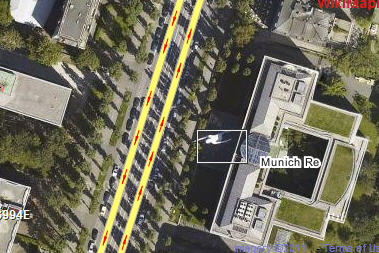
I told the cab driver to let us out when we got to the restaurant area just beyond there. Here are some of the street scenes.
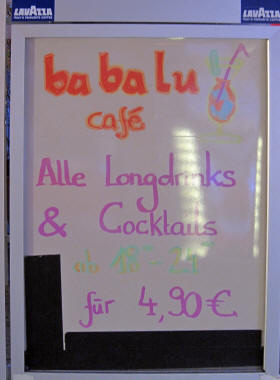
We passed a place called Ba Ba Lu (we eat a lot at the Babalu in Santa Monica) and then Don Luca's Cantina Mexicana [44 Leopoldstrasse, +49-893-301-9330.] Threads I found online my experienced long time residents say there are really no good Mexican restaurants in Munich.
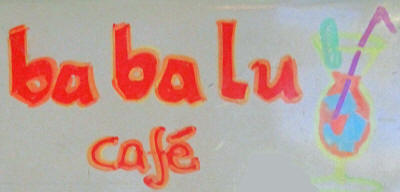
We finally were getting close when we passed the big bus and taxi station at Feilitzschplatz. See map of our walk above.
We finally found it and at 9:00 we went for dinner at Al Pacino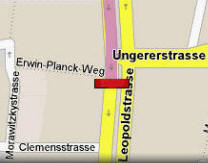
[87 Leopoldstra�e, +49-8-933-2555.]
It is just before Ungerstra�e near Erwin Plank Weg. We decided to get a
table inside even though it seemed everyone else was sitting at the outdoor
tables. It was a little warm but not bad. I asked our waiter if this
place was owned by THE Al Pacino and he told us it wasn't. How can they
use his name then? Well, the owner-chef's name happens to be Al Pacino.
He asked if we wanted a picture, so we said OK.
Our table was over in the corner. Here is their shot of the outdoor seating during the day.
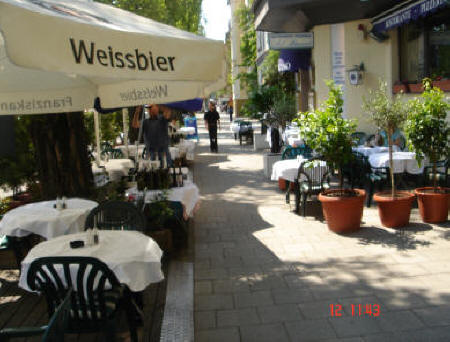
There menu is quite extensive and we decided to skip having a pizza.
We ordered a bottle of familiar Orvieto Classico'06 by Bigi (16.5) which I get at home and I also had a large Coka-lite (4;) I was really thirsty. They brought us each a complimentary bruschetta (toasted bread with diced tomatoes, greens and slices of parmagiano reggiano cheese which was very tasty.
I was in the mood for pasta, so first I had a plate of spaghetti bolognese (6) followed by rigatoni alla panna (6) which came with tiny thin slices of ham.
All Marcia had was an order of vitello alla vino bianco (veal in white wine) (11.5) which came with cauliflower, broccoli, green beans and boiled potatoes.
Marcia got some dressing for the salad that came with it. For dessert we shared a panna cotta menthe (mint) (4.5) and Marcia had a glass of Marzadro (sweet wine.)
Our waiter was Gianluca (below left) and I asked him why the lighted "P" in the ceiling (below right) was backwards. He had no explanation and no one had ever mentioned it - they thought it was just fine. We rated the dinner Good but not excellent. It is open everyday from 11:30 AM to midnight, so I good late-night place to eat.
At 10:20, we left the restaurant and, of course Marcia wanted to get a cab but I came up with a more economical idea. We
walked to the nearest Ubahn station at the end of the block, M�nchner Freiheit
(below) and worked our way down the escalator and tunnels to take the U3-Bahn to
Marienplatz at 10:30.
came up with a more economical idea. We
walked to the nearest Ubahn station at the end of the block, M�nchner Freiheit
(below) and worked our way down the escalator and tunnels to take the U3-Bahn to
Marienplatz at 10:30.
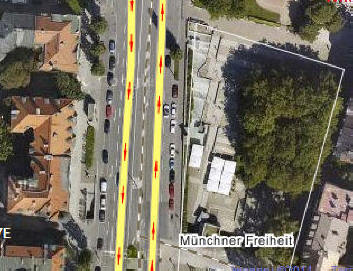
Notice how clean and graffiti-free this all is. There's not a piece of paper, coke or beer can, plastic bottle or cigarette butt anywhere.
It was a quick, smooth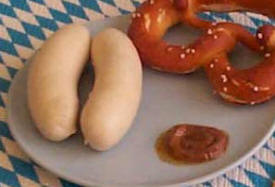 ride and after we arrived at the station and climbed out, we walked around
Marienplatz a little while and at 10:40 we
settled on sitting down at Caf� Am
Marienplatz [22 Marienplatz , +49-892-388-6696]
which claims to be the birthplace of the Munich Wei�wurst, the white bratwurst
(right.) It was a creation of the Wirtsmetzger Josef Moser
in 1857. Here are some of their photos of the interior of the
place, obviously when its rather quiet.
ride and after we arrived at the station and climbed out, we walked around
Marienplatz a little while and at 10:40 we
settled on sitting down at Caf� Am
Marienplatz [22 Marienplatz , +49-892-388-6696]
which claims to be the birthplace of the Munich Wei�wurst, the white bratwurst
(right.) It was a creation of the Wirtsmetzger Josef Moser
in 1857. Here are some of their photos of the interior of the
place, obviously when its rather quiet.
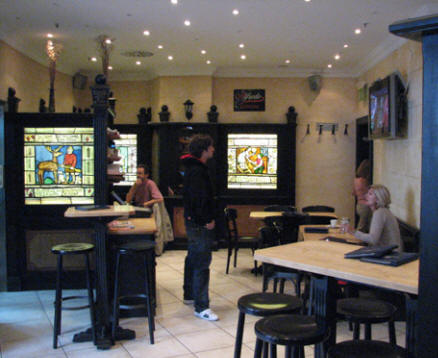
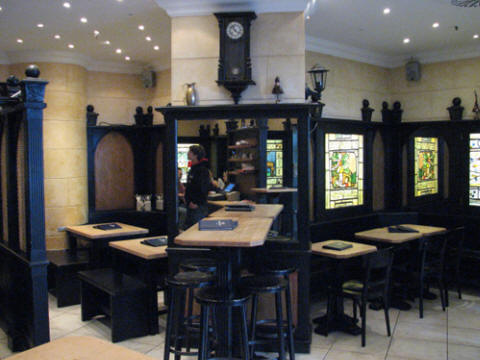
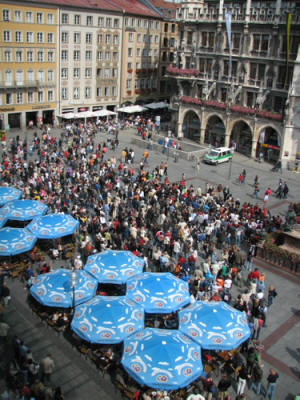
The Ratskeller in the Neues Rathaus (above right) is, of course, in the basement (keller) but it also extends to the courtyard (below) in the center of the building which is also quite enchantingly Medieval.
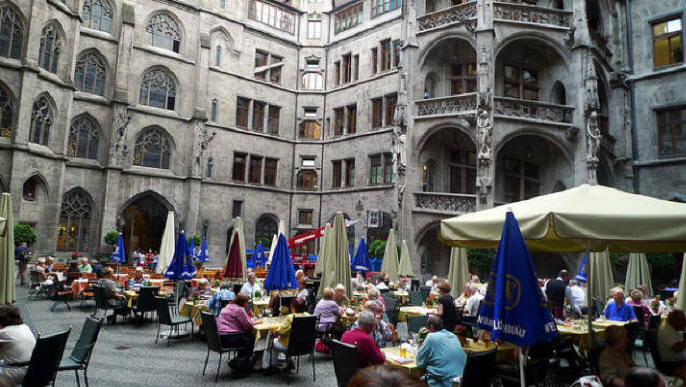
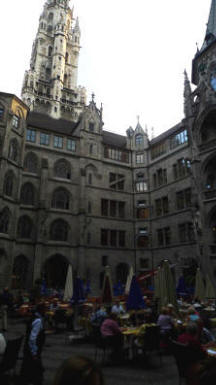
This is where I brought Marcia in 1999, when she didn't like Germany very much, because they had a wine festival here. She enjoyed it.
We sat at a table outside to enjoy watching the people pass by. As you can see from their daytime photos, at Am Marienplatz, you are right in the middle of it all.
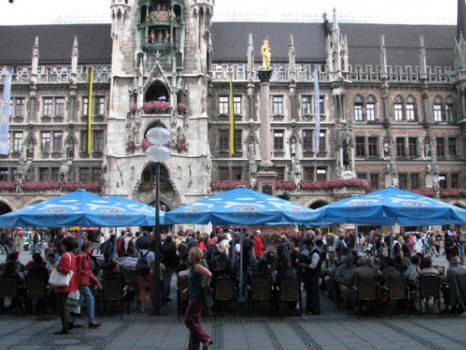
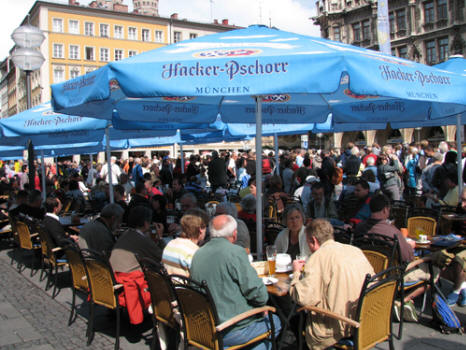

I ordered a Hacker-Pschorr tap beer and Marcia had a Sauvignon blanc by JP Chenet. As usual, this is the only beer they serve here; Hacker-Pschorr is one of the Munich's major breweries and claims to have started in 1417.
At 11:35 we walked backed to our room and on the way I took a shot of this statue we pass by everyday. It is of Sigi Sommer, a Munich writer and journalist (1914-96.)
Someone left a flower there in an empty champagne bottle. We got back to the room and at 12:10 AM. I called Kevin and got to bed at 12:20. Another exhausting day.
Kenneth J. Hoffer, MD
Munich, Germany
8-22-2010
Sent 3/6/2011
If you enjoyed these travels or wish to add comments on the places we visited
Please Leave Me a Message by clicking the spinning @ sign below.

